An Event-Based Resilience Index to Assess the Impacts of Land Imperviousness and Climate Changes on Flooding Risks in Urban Drainage Systems
Abstract
1. Introduction
2. Methodology
2.1. The Study Area
2.2. Baseline and Future Rainfalls
2.2.1. Observed Rainfall Data
2.2.2. Climate Change and Downscaling Methods
2.2.3. Future Rainfalls
2.3. Urban Redevelopment and Future Imperviousness
2.4. Future Scenarios
2.5. Flooding Resilience Index
3. Results
3.1. Impacts on System Performance
3.2. Impacts on Flooding Resilience
3.3. Impacts on Nodal Resilience
3.4. Resilience Sensitivity Analysis
3.5. Flooding Resilience Comparison
4. Discussions
5. Conclusions
- The proposed event-based flooding resilience metric can accurately and consistently quantify the climatic and urbanized effects, together and alone, on resilience values at different spatial levels. At the system level, the advantage of the proposed index is to reflect the realistic system performance without underestimating the flooding magnitude and duration. At the junction level, the new resilience metric enables the engineers and decision-makers to identify the most vulnerable spots and then initiate early actions for mitigating structural failure risks.
- This study fills an important gap in weighing the importance of future climate change and urban redevelopment on flooding resilience. Our results show that the imperviousness percentage changes caused by urban infill induce more significant impacts on system performance curves than the rainfall intensity changes. With this information, local utilities can prioritize adaptation measures, namely improving the previous landscape, adding local stormwater treatment practices along with the urban redeveloping projects, or issuing adaptive land management policies, for buffering the rapid urbanization process but not diverting too many valuable resources into resisting the threats from climatic changes.
- A nonlinear logarithmic correlation shows that flooding resilience is more sensitive to the growth in impervious surfaces than intensified rainfalls. A 20% increase in urbanization scenarios leads to approximately a 29% decrease in system resilience, while a 20% increase in the climatic scenario only results in around a 16% decline in resilience by 2100. This quantitative correlation is crucial for the design and renovation of the urban drainage system, aimed to adapt to land cover and climate change in the future. Although the sensitivity correlation might vary from case to case, this study contributes to promoting the awareness of including future uncertain disturbances in resilient urban drainage design.
Author Contributions
Funding
Data Availability Statement
Conflicts of Interest
References
- Butler, D.; Parkinson, J. Towards sustainable urban drainage. Water Sci. Technol. 1997, 35, 53–63. [Google Scholar] [CrossRef]
- Arnbjerg-Nielsen, K.; Willems, P.; Olsson, J.; Beecham, S.; Pathirana, A.; Bülow Gregersen, I.; Madsen, H.; Nguyen, V.T.V. Impacts of climate change on rainfall extremes and urban drainage systems: A review. Water Sci. Technol. 2013, 68, 16–28. [Google Scholar] [CrossRef] [PubMed]
- Kim, Y.; Eisenberg, D.A.; Bondank, E.N.; Chester, M.V.; Mascaro, G.; Underwood, B.S. Fail-safe and safe-to-fail adaptation: Decision-Making for urban flooding under climate change. Clim. Chang. 2017, 145, 397–412. [Google Scholar] [CrossRef]
- Mohammadiun, S.; Yazdi, J.; Hager, J.; Salehi Neyshabouri, S.A.A.; Sadiq, R.; Hewage, K.; Alavi Gharahbagh, A. Effects of bottleneck blockage on the resilience of an urban stormwater drainage system. Hydrol. Sci. J. 2020, 65, 281–295. [Google Scholar] [CrossRef]
- Li, J.; Burian, S.; Carlos, O.; Johnson, R.C. Modeling Operations in System-level Real-time Control for Urban Flooding Reduction and Water Quality Improvement—An Open-source Benchmarked Case. Authorea 2023. Preprint. [Google Scholar] [CrossRef]
- Skougaard Kaspersen, P.; Høegh Ravn, N.; Arnbjerg-Nielsen, K.; Madsen, H.; Drews, M. Comparison of the impacts of urban development and climate change on exposing European cities to pluvial flooding. Hydrol. Earth Syst. Sci. 2017, 21, 4131–4147. [Google Scholar] [CrossRef]
- Huong, H.T.L.; Pathirana, A. Urbanization and climate change impacts on future urban flooding in Can Tho city, Vietnam. Hydrol. Earth Syst. Sci. 2013, 17, 379–394. [Google Scholar] [CrossRef]
- Semadeni-Davies, A.; Hernebring, C.; Svensson, G.; Gustafsson, L.G. The impacts of climate change and urbanisation on drainage in Helsingborg, Sweden: Combined sewer system. J. Hydrol. 2008, 350, 100–113. [Google Scholar] [CrossRef]
- Holling, C.S. Resilience and Stability. Annu. Rev. Ecol. Syst. 1973, 4, 1–23. [Google Scholar] [CrossRef]
- Holling, C.S. Engineering resilience versus ecological resilience. Natl. Acad. Eng. 1996, 31, 32. [Google Scholar]
- Blackmore, J.M.; Plant, R.A.J. Risk and resilience to enhance sustainability with application to urban water systems. J. Water Resour. Plan. Manag. 2008, 134, 224–233. [Google Scholar] [CrossRef]
- Butler, D.; Ward, S.; Sweetapple, C.; Astaraie-Imani, M.; Diao, K.; Farmani, R.; Fu, G. Reliable, resilient and sustainable water management: The Safe & SuRe approach. Glob. Chall. 2017, 1, 63–77. [Google Scholar] [CrossRef] [PubMed]
- Casal-Campos, A.; Sadr, S.M.K.; Fu, G.; Butler, D. Reliable, Resilient and Sustainable Urban Drainage Systems: An Analysis of Robustness under Deep Uncertainty. Environ. Sci. Technol. 2018, 52, 9008–9021. [Google Scholar] [CrossRef]
- Juan-García, P.; Butler, D.; Comas, J.; Darch, G.; Sweetapple, C.; Thornton, A.; Corominas, L. Resilience theory incorporated into urban wastewater systems management. State of the art. Water Res. 2017, 115, 149–161. [Google Scholar] [CrossRef] [PubMed]
- Ahern, J. From fail-safe to safe-to-fail: Sustainability and resilience in the new urban world. Landsc. Urban Plan. 2011, 100, 341–343. [Google Scholar] [CrossRef]
- Ouyang, M.; Dueñas-Osorio, L.; Min, X. A three-stage resilience analysis framework for urban infrastructure systems. Struct. Saf. 2012, 36, 23–31. [Google Scholar] [CrossRef]
- Park, J.; Seager, T.P.; Rao, P.S.C. Lessons in risk- versus resilience-based design and management. Integr. Environ. Assess. Manag. 2011, 7, 396–399. [Google Scholar] [CrossRef] [PubMed]
- Park, J.; Seager, T.P.; Rao, P.S.C.; Convertino, M.; Linkov, I. Integrating risk and resilience approaches to catastrophe management in engineering systems. Risk Anal. 2013, 33, 356–367. [Google Scholar] [CrossRef]
- Mugume, S.N. Modelling and Resilience-Based Evaluation of Urban Drainage and Flood Management Systems for Future Cities. Ph.D. Thesis, University of Exeter, Exeter, UK, 2015. [Google Scholar]
- Mugume, S.N.; Gomez, D.E.; Fu, G.; Farmani, R.; Butler, D. A global analysis approach for investigating structural resilience in urban drainage systems. Water Res. 2015, 81, 15–26. [Google Scholar] [CrossRef]
- Lee, E.H.; Lee, Y.S.; Joo, J.G.; Jung, D.; Kim, J.H. Investigating the impact of proactive pump operation and capacity expansion on urban drainage system resilience. J. Water Resour. Plan. Manag. 2017, 143, 04017024. [Google Scholar] [CrossRef]
- Yazdi, J. Rehabilitation of Urban Drainage Systems Using a Resilience-Based Approach. Water Resour. Manag. 2018, 32, 721–734. [Google Scholar] [CrossRef]
- Wang, Y.; Meng, F.; Liu, H.; Zhang, C.; Fu, G. Assessing catchment scale flood resilience of urban areas using a grid cell based metric. Water Res. 2019, 163, 114852. [Google Scholar] [CrossRef]
- Xiong, L.; Yan, L.; Du, T.; Yan, P.; Li, L.; Xu, W. Impacts of Climate Change on Urban Extreme Rainfall and Drainage Infrastructure Performance: A Case Study in Wuhan City, China. Irrig. Drain. 2019, 68, 152–164. [Google Scholar] [CrossRef]
- Li, J.; Tao, T.; Kreidler, M.; Burian, S.; Yan, H. Construction Cost-Based Effectiveness Analysis of Green and Grey Infrastructure in Controlling Flood Inundation: A Case Study. J. Water Manag. Model. 2019, 27, C466. [Google Scholar] [CrossRef]
- Zhou, Q.; Ren, Y.; Xu, M.; Han, N.; Wang, H. Adaptation to urbanization impacts on drainage in the city of Hohhot, China. Water Sci. Technol. 2016, 73, 167–175. [Google Scholar] [CrossRef] [PubMed]
- Ntelekos, A.A.; Oppenheimer, M.; Smith, J.A.; Miller, A.J. Urbanization, climate change and flood policy in the United States. Clim. Change 2010, 103, 597–616. [Google Scholar] [CrossRef]
- Pond, M.C.; Dietz, C. Tear-Downs: Controlling Stormwater Impacts. Available online: http://waterbucket.ca/gi/files/2013/03/Teardowns-controlling-stormwaterimpacts.%0Apdf (accessed on 6 July 2020).
- Panos, C.L.; Hogue, T.S.; Gilliom, R.L.; McCray, J.E. High-Resolution Modeling of Infill Development Impact on Stormwater Dynamics in Denver, Colorado. J. Sustain. Water Built Environ. 2018, 4, 04018009. [Google Scholar] [CrossRef]
- Li, J. Exploring the potential of utilizing unsupervised machine learning for urban drainage sensor placement under future rainfall uncertainty. J. Environ. Manag. 2021, 296, 113191. [Google Scholar] [CrossRef]
- Li, J. A data-driven improved fuzzy logic control optimization-simulation tool for reducing flooding volume at downstream urban drainage systems. Sci. Total Environ. 2020, 732, 138931. [Google Scholar] [CrossRef]
- Li, J.; Burian, S.; Oroza, C. Exploring the potential for simulating system-level controlled smart stormwater system. In Proceedings of the World Environmental and Water Resources Congress 2019: Water, Wastewater, and Stormwater; Urban Water Resources; and Municipal Water Infrastructure—Selected Papers from the World Environmental and Water Resources Congress 2019, Pittsburgh, PA, USA, 19–23 May 2019; American Society of Civil Engineers: Reston, VA, USA, 2019; pp. 46–56. [Google Scholar]
- Yao, L.; Wei, W.; Chen, L. How does imperviousness impact the urban rainfall-runoff process under various storm cases? Ecol. Indic. 2016, 60, 893–905. [Google Scholar] [CrossRef]
- Kong, F.; Ban, Y.; Yin, H.; James, P.; Dronova, I. Modeling stormwater management at the city district level in response to changes in land use and low impact development. Environ. Model. Softw. 2017, 95, 132–142. [Google Scholar] [CrossRef]
- Madsen, H.; Lawrence, D.; Lang, M.; Martinkova, M.; Kjeldsen, T.R. Review of trend analysis and climate change projections of extreme precipitation and floods in Europe. J. Hydrol. 2014, 519, 3634–3650. [Google Scholar] [CrossRef]
- Panos, C.L.; Wolfand, J.M.; Hogue, T.S. SWMM Sensitivity to LID Siting and Routing Parameters: Implications for Stormwater Regulatory Compliance. J. Am. Water Resour. Assoc. 2020, 56, 790–809. [Google Scholar] [CrossRef]
- Hekl, J.A.; Dymond, R.L. Runoff Impacts and LID Techniques for Mansionization-Based Stormwater Effects in Fairfax County, Virginia. J. Sustain. Water Built Environ. 2016, 2, 05016001. [Google Scholar] [CrossRef]
- Oberascher, M.; Dastgir, A.; Li, J.; Hesarkazzazi, S.; Hajibabaei, M.; Rauch, W.; Sitzenfrei, R. Revealing the challenges of smart rainwater harvesting for integrated and digital resilience of urban water infrastructure. Water 2021, 13, 1902. [Google Scholar] [CrossRef]
- Li, J.; Yang, X.; Sitzenfrei, R. Rethinking the framework of smart water system: A review. Water 2020, 12, 412. [Google Scholar] [CrossRef]
- Wang, S.; Fu, J.; Wang, H. Unified and rapid assessment of climate resilience of urban drainage system by means of resilience profile graphs for synthetic and real (persistent) rains. Water Res. 2019, 162, 11–21. [Google Scholar] [CrossRef]
- Dong, X.; Guo, H.; Zeng, S. Enhancing future resilience in urban drainage system: Green versus grey infrastructure. Water Res. 2017, 124, 280–289. [Google Scholar] [CrossRef]
- Putro, B.; Kjeldsen, T.R.; Hutchins, M.G.; Miller, J. An empirical investigation of climate and land-use effects on water quantity and quality in two urbanising catchments in the southern United Kingdom. Sci. Total Environ. 2016, 548–549, 164–172. [Google Scholar] [CrossRef] [PubMed]
- Salerno, F.; Viviano, G.; Tartari, G. Urbanization and climate change impacts on surface water quality: Enhancing the resilience by reducing impervious surfaces. Water Res. 2018, 144, 491–502. [Google Scholar] [CrossRef]
- Carter, T.R.; Alfsen, K.; Barrow, E.; Bass, B.; Dai, X.; Desanker, P. IPCC-TGICA: General Guidelines on the Use of Scenario Data for Climate Impact and Adaptation Assessment (TGICA), Version 2. 2007. Available online: https://www.ipcc-data.org/guidelines/TGICA_guidance_sdciaa_v2_final.pdf (accessed on 6 July 2020).
- Rossman, L.A. Storm Water Management Model User’s Manual Version 5.1. EPA/600/R-14/413b; National Risk Management Research Laboratory Office of Research and Development, United States Environmental Protection Agency: Cincinnati, OH, USA, 2015. [Google Scholar]
- Li, J.; Burian, S.J. Effects of Nonstationarity in Urban Land Cover and Rainfall on Historical Flooding Intensity in a Semiarid Catchment. J. Sustain. Water Built Environ. 2022, 8, 04022002. [Google Scholar] [CrossRef]
- Li, J.; Bortolot, Z.J. Quantifying the impacts of land cover change on catchment-scale urban flooding by classifying aerial images. J. Clean. Prod. 2022, 344, 130992. [Google Scholar] [CrossRef]
- Web Soil Survey “Web Soil Survey”. USDA. Available online: https://websoilsurvey.sc.egov.usda.gov/App/WebSoilSurvey.aspx (accessed on 10 July 2022).
- NOAA Climate Prediction Center. Available online: https://www.cpc.ncep.noaa.gov/products/predictions/814day/ (accessed on 2 January 2021).
- Dunkerley, D. Identifying individual rain events from pluviograph records: A review with analysis of data from an Australian dryland site. Hydrol. Process. 2008, 22, 5024–5036. [Google Scholar] [CrossRef]
- Cao, S.; Diao, Y.; Wang, J.; Liu, Y.; Raimondi, A.; Wang, J. KDE-Based Rainfall Event Separation and Characterization. Water 2023, 15, 580. [Google Scholar] [CrossRef]
- Anandhi, A.; Frei, A.; Pierson, D.C.; Schneiderman, E.M.; Zion, M.S.; Lounsbury, D.; Matonse, A.H. Examination of change factor methodologies for climate change impact assessment. Water Resour. Res. 2011, 47, 1–10. [Google Scholar] [CrossRef]
- Brekke, L.; Thrasher, B.L.; Maurer, E.P.; Pruitt, T. Downscaled CMIP3 and CMIP5 Climate Projections: Release of Downscaled CMIP5 Climate Projections, Comparison with Preceding Information, and Summary of User Needs; US Department of the Interior: Denver, CO, USA, 2013. [Google Scholar]
- Zhou, Q.; Leng, G.; Huang, M. Impacts of future climate change on urban flood volumes in Hohhot in northern China: Benefits of climate change mitigation and adaptations. Hydrol. Earth Syst. Sci. 2018, 22, 305–316. [Google Scholar] [CrossRef]
- Smith, K.; Strong, C.; Wang, S.Y. Connectivity between historical great basin precipitation and Pacific ocean variability: A CMIP5 model evaluation. J. Clim. 2015, 28, 6096–6112. [Google Scholar] [CrossRef]
- Choi, W.; Rasmussen, P.; Moore, A.; Kim, S. Simulating streamflow response to climate scenarios in central Canada using a simple statistical downscaling method. Clim. Res. 2009, 40, 89–102. [Google Scholar] [CrossRef]
- Graham, L.P.; Andreáasson, J.; Carlsson, B. Assessing climate change impacts on hydrology from an ensemble of regional climate models, model scales and linking methods—A case study on the Lule River basin. Clim. Change 2007, 81, 293–307. [Google Scholar] [CrossRef]
- Jung, I.W.; Chang, H.; Moradkhani, H. Quantifying uncertainty in urban flooding analysis considering hydro-climatic projection and urban development effects. Hydrol. Earth Syst. Sci. 2011, 15, 617–633. [Google Scholar] [CrossRef]
- Wilby, R.L.; Hay, L.E.; Gutowski, W.J.; Arritt, R.W.; Takle, E.S.; Pan, Z.; Leavesley, G.H.; Clark, M.P. Hydrological responses to dynamically and statistically downscaled climate model output. Geophys. Res. Lett. 2000, 27, 1199–1202. [Google Scholar] [CrossRef]
- Hay, L.E.; Wilby, R.L.; Leavesley, G.H. A comparison of delta change and downscaled GCM scenarios for three mountainous basins in the United States. J. Am. Water Resour. Assoc. 2000, 36, 387–397. [Google Scholar] [CrossRef]
- Leandro, J.; Chen, K.F.; Wood, R.R.; Ludwig, R. A scalable flood-resilience-index for measuring climate change adaptation: Munich city. Water Res. 2020, 173, 115502. [Google Scholar] [CrossRef] [PubMed]
- Cherry, L.; Mollendor, D.; Eisenstein, B.; Hogue, T.S.; Peterman, K.; McCray, J.E. Predicting parcel-scale redevelopment using linear and logistic regression-The Berkeley neighborhood Denver, Colorado case study. Sustainability 2019, 11, 1882. [Google Scholar] [CrossRef]
- Du, J.; Qian, L.; Rui, H.; Zuo, T.; Zheng, D.; Xu, Y.; Xu, C.Y. Assessing the effects of urbanization on annual runoff and flood events using an integrated hydrological modeling system for Qinhuai River basin, China. J. Hydrol. 2012, 464, 127–139. [Google Scholar] [CrossRef]
- Hamdi, R.; Termonia, P.; Baguis, P. Effects of urbanization and climate change on surface runoff of the Brussels Capital Region: A case study using an urban soil-vegetation-atmosphere-transfer model. Int. J. Climatol. 2011, 31, 1959–1974. [Google Scholar] [CrossRef]
- Nelson, K.C.; Palmer, M.A.; Pizzuto, J.E.; Moglen, G.E.; Angermeier, P.L.; Hilderbrand, R.H.; Dettinger, M.; Hayhoe, K. Forecasting the combined effects of urbanization and climate change on stream ecosystems: From impacts to management options. J. Appl. Ecol. 2009, 46, 154–163. [Google Scholar] [CrossRef]
- U.S. EPA Estimating Change in Impervious Area (IA) and Directly Connected Impervious Areas (DCIA) for Small MS4 Permit. Available online: https://www3.epa.gov/region1/npdes/stormwater/ma/MADCIA.pdf (accessed on 7 March 2020).
- Hwang, H.; Lansey, K.; Quintanar, D.R. Resilience-based failure mode effects and criticality analysis for regional water supply system. J. Hydroinformatics 2015, 17, 193–210. [Google Scholar] [CrossRef]
- Mugume, S.; Gomez, D.; Butler, D. Quantifying the Resilience of Urban Drainage Systems Using a Hydraulic Performance Assessment Approach. In Proceedings of the 13th International Conference on Urban Drainage; IAHR (International Association for Hydro-Environment)/IWA (International Water Association), Sarawak, Malaysia, 7–11 September 2014; pp. 7–12. [Google Scholar]
- Li, J.; Burian, S.; Ryan, J.; Oroza, C. Exploring Cost-effective Implementation of Real-time Control to Enhance Flooding Resilience against Future Rainfall and Land Cover Changes. Authorea 2023. Preprint. [Google Scholar] [CrossRef]
- Li, J.; Hansen, C.; Burian, S. Understanding rainfall nonstationarity to incubate adaptive stormwater infrastructure retrofits. Authorea 2023. Preprint. [Google Scholar] [CrossRef]
- Zhou, Q.; Leng, G.; Su, J.; Ren, Y. Comparison of urbanization and climate change impacts on urban flood volumes: Importance of urban planning and drainage adaptation. Sci. Total Environ. 2019, 658, 24–33. [Google Scholar] [CrossRef] [PubMed]
- Jung, M.; Kim, H.; Mallari, K.J.B.; Pak, G.; Yoon, J. Analysis of effects of climate change on runoff in an urban drainage system: A case study from Seoul, Korea. Water Sci. Technol. 2015, 71, 653–660. [Google Scholar] [CrossRef]
- Li, J.; Burian, S. Evaluating real-time control of stormwater drainage network and green stormwater infrastructure for enhancing flooding resilience under future rainfall projections. Authorea 2023. Preprint. [Google Scholar] [CrossRef]
- Li, J. The Performance Comparison between RTC and GI to Mitigate Impacts of Climate Change and Urban Redevelopment on Urban Flooding. Authorea 2023. Preprint. [Google Scholar] [CrossRef]
- Kastridis, A.; Kirkenidis, C.; Sapountzis, M. An integrated approach of flash flood analysis in ungauged Mediterranean watersheds using post-flood surveys and unmanned aerial vehicles. Hydrol. Process. 2020, 15, 4920–4939. [Google Scholar] [CrossRef]
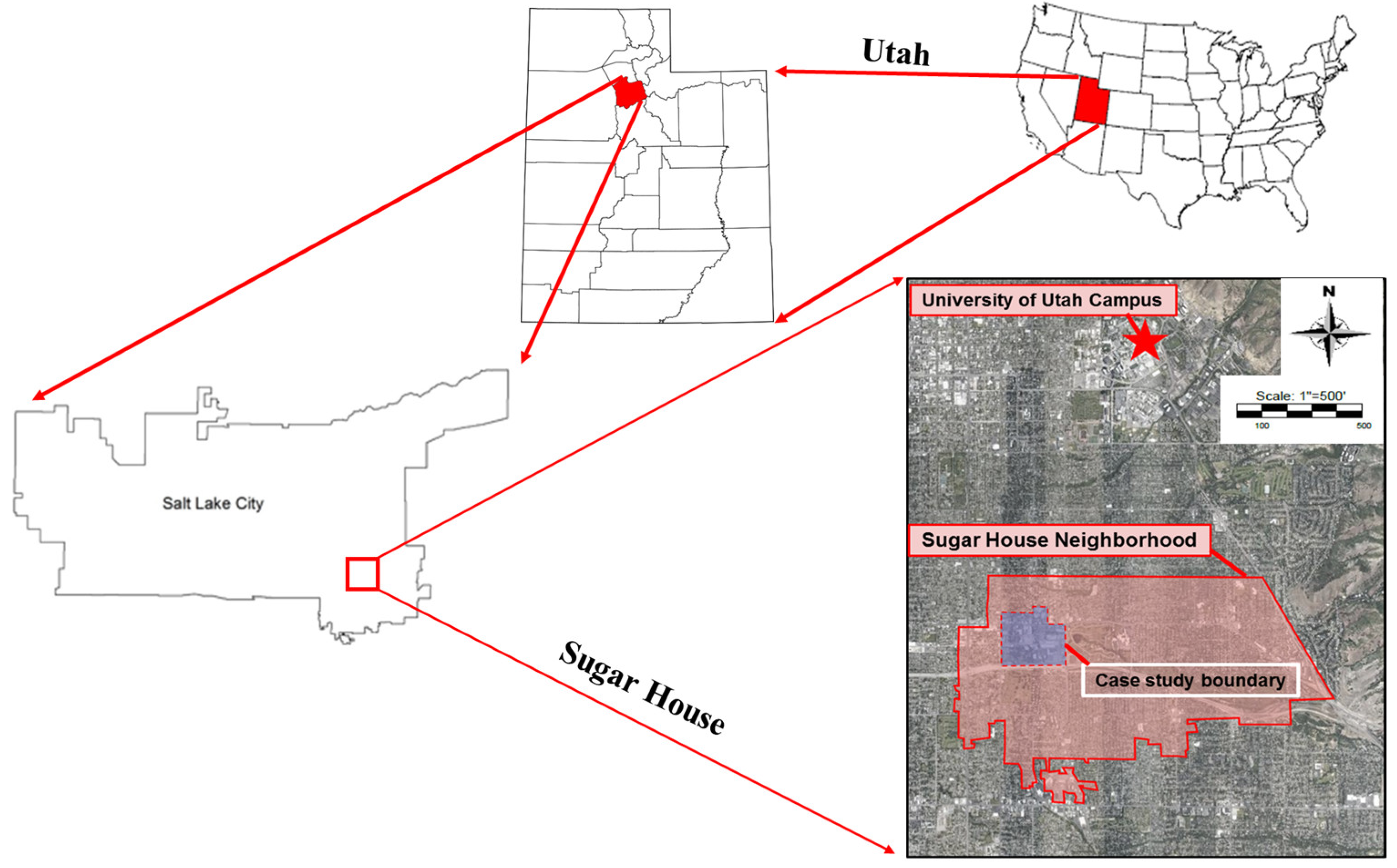

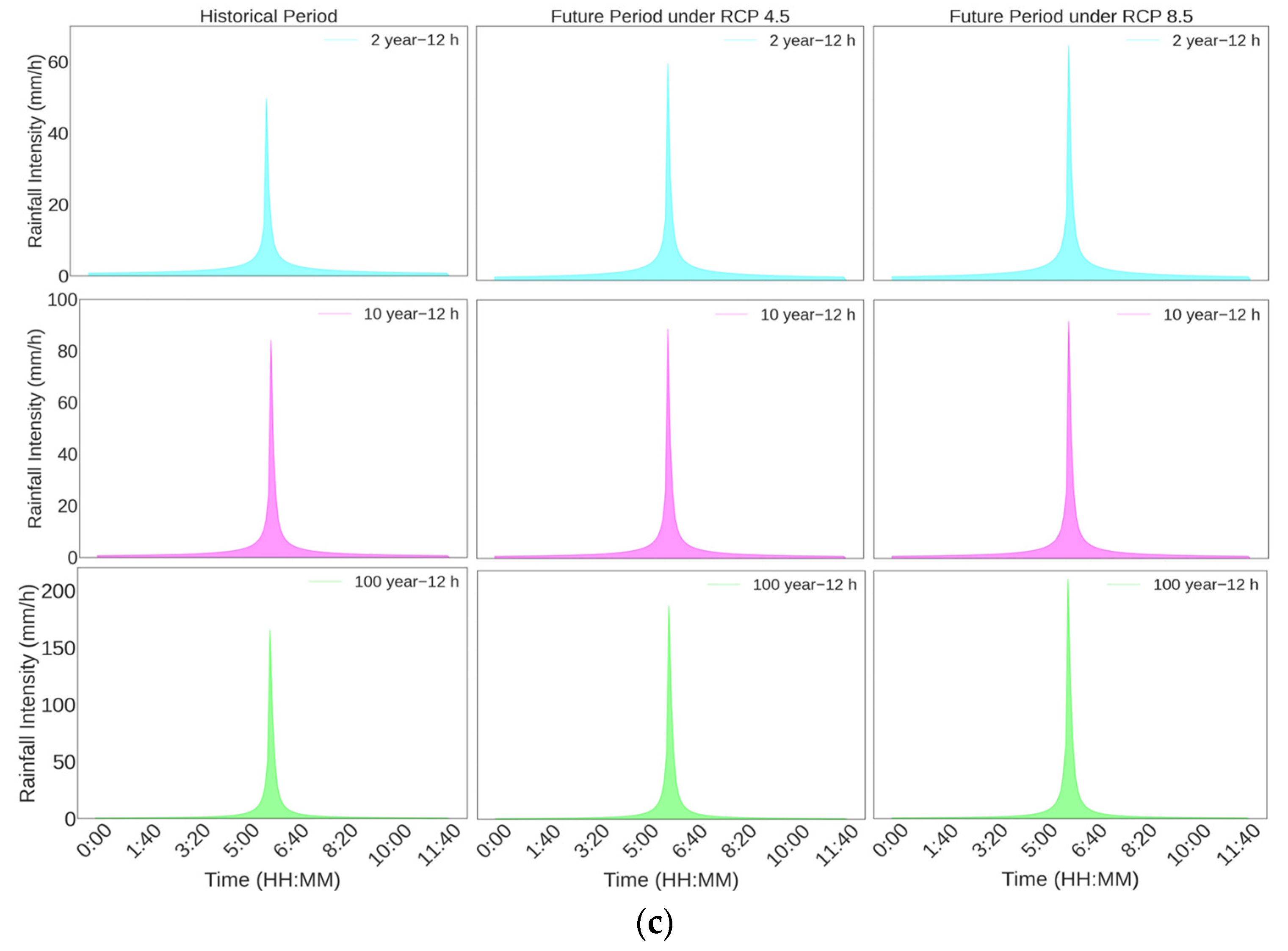


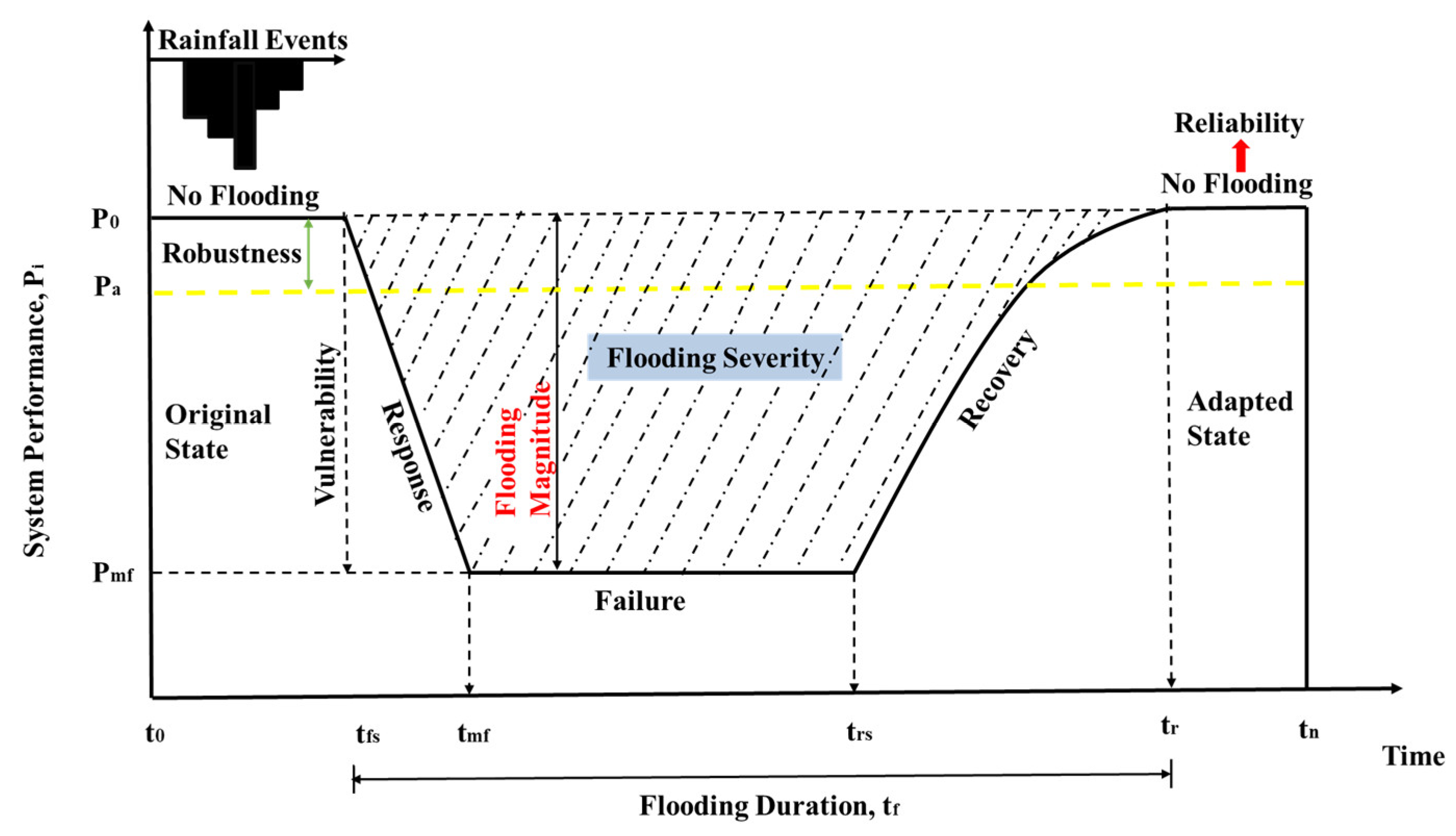

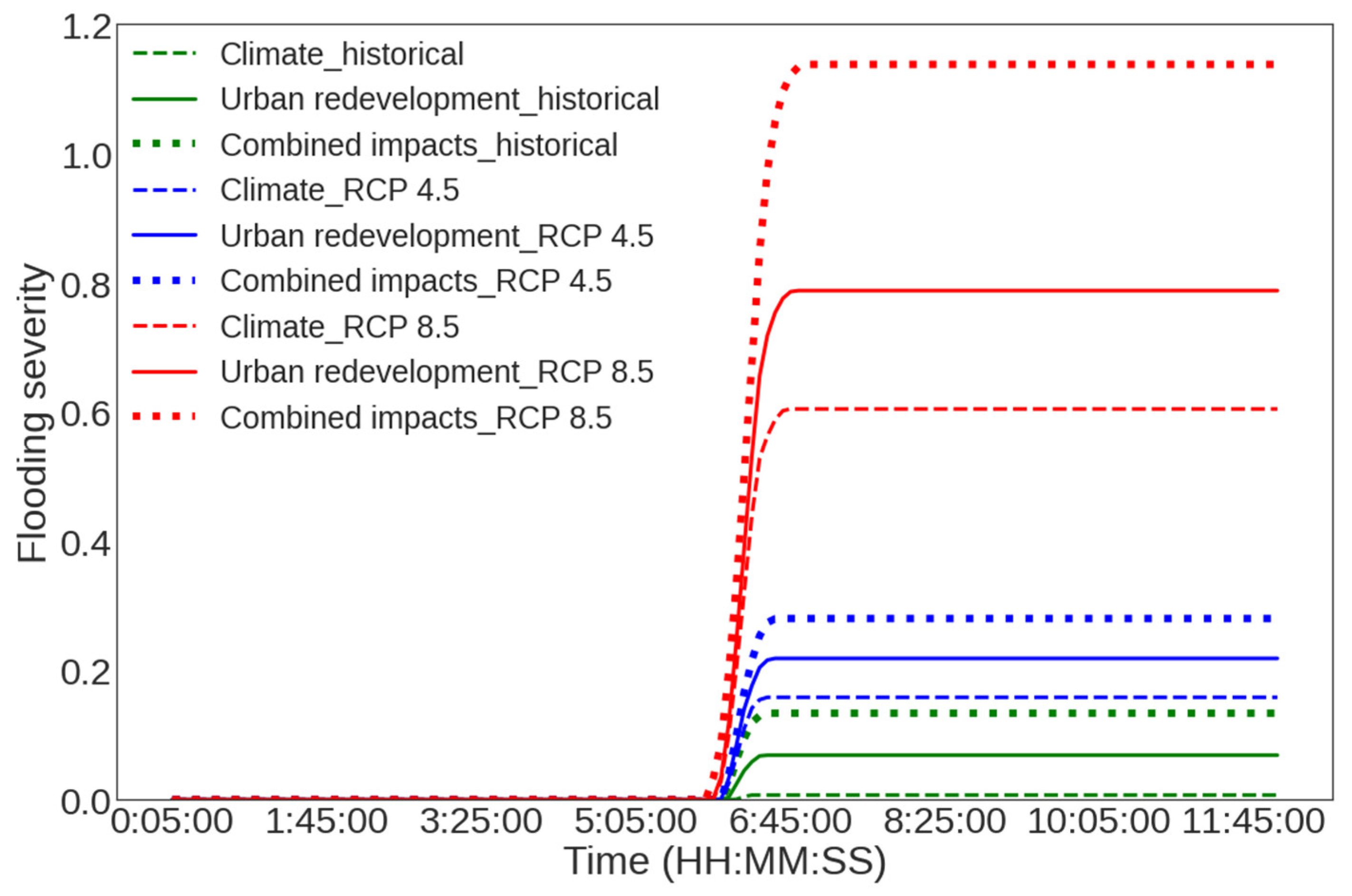

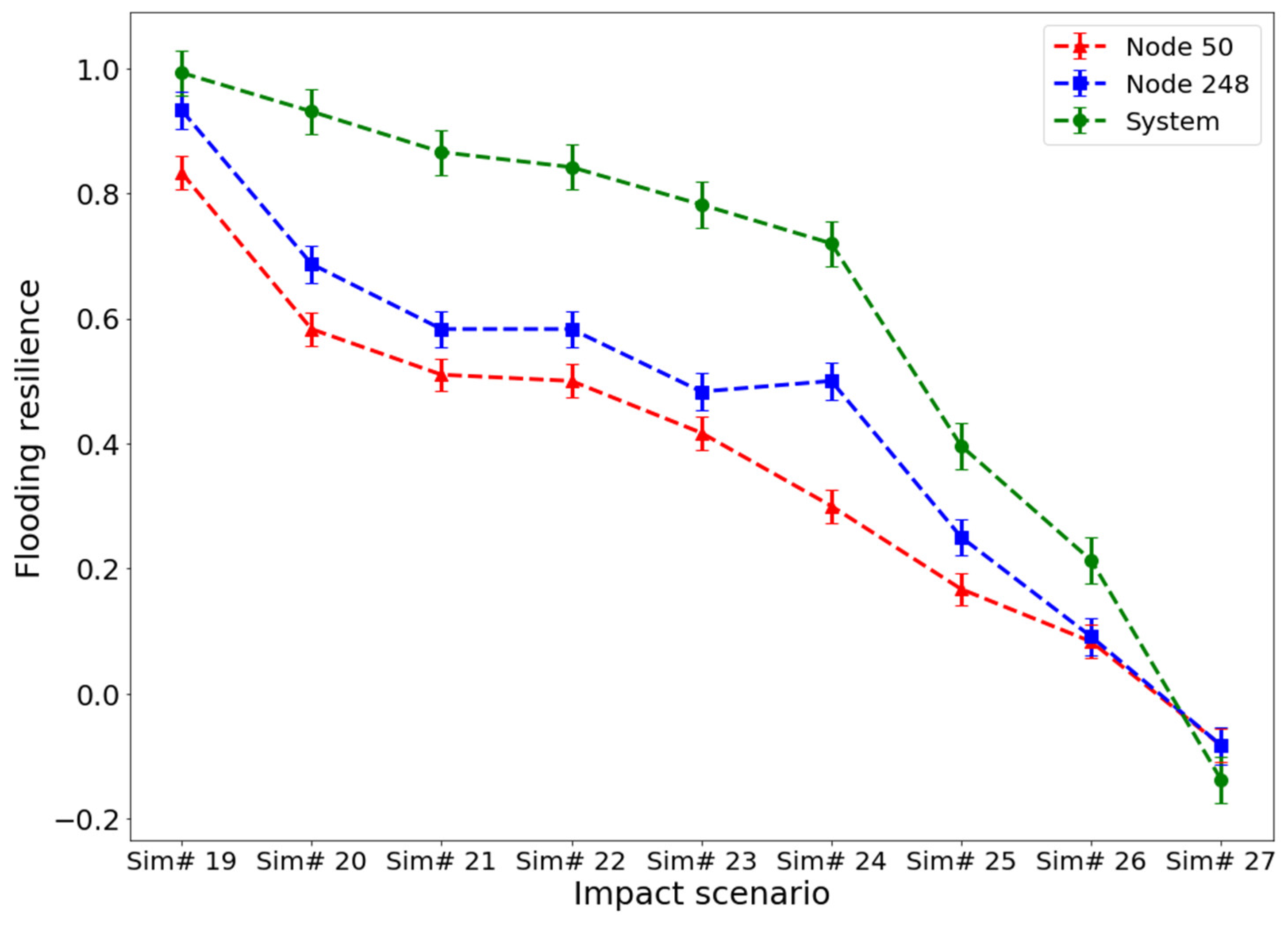
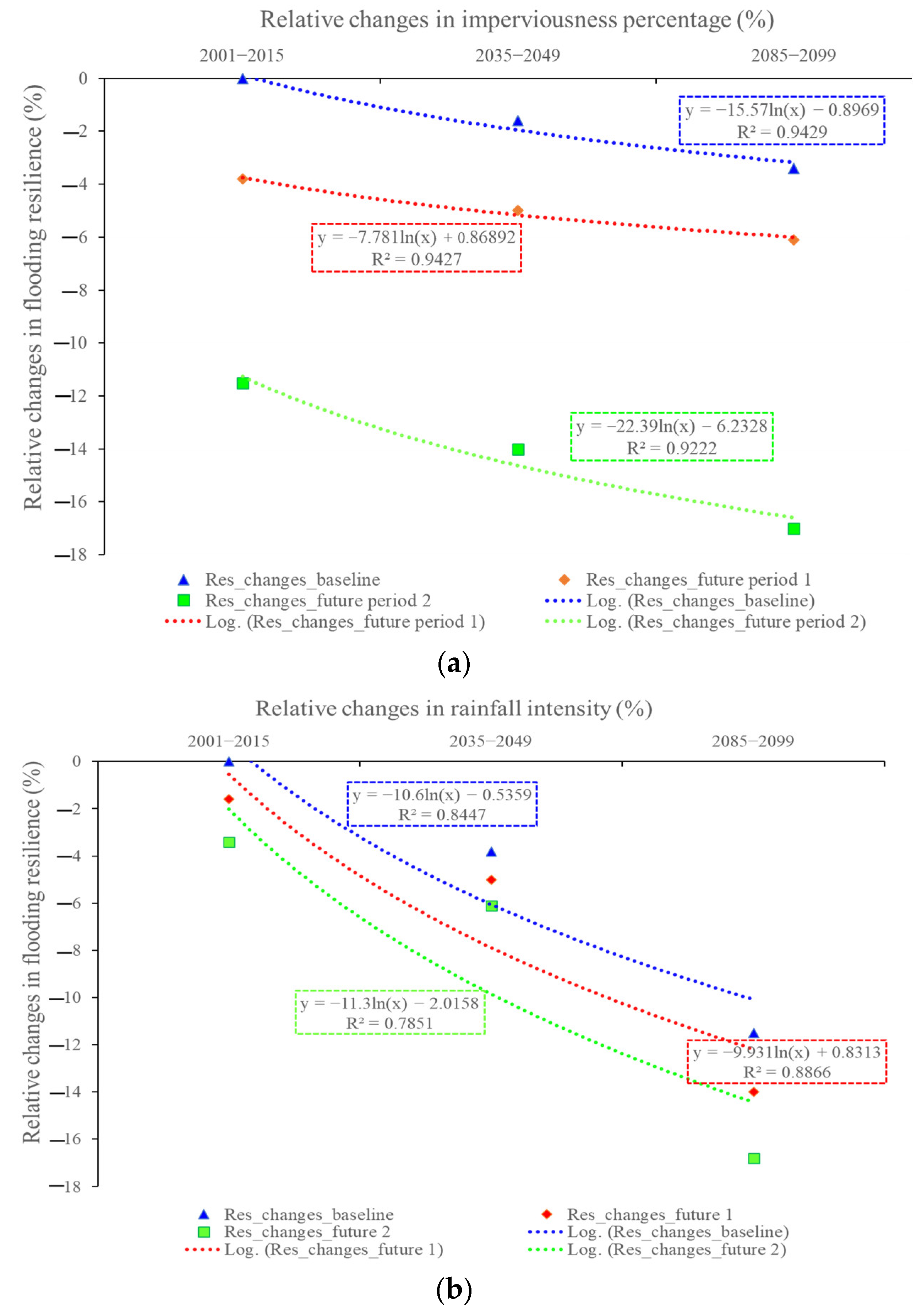
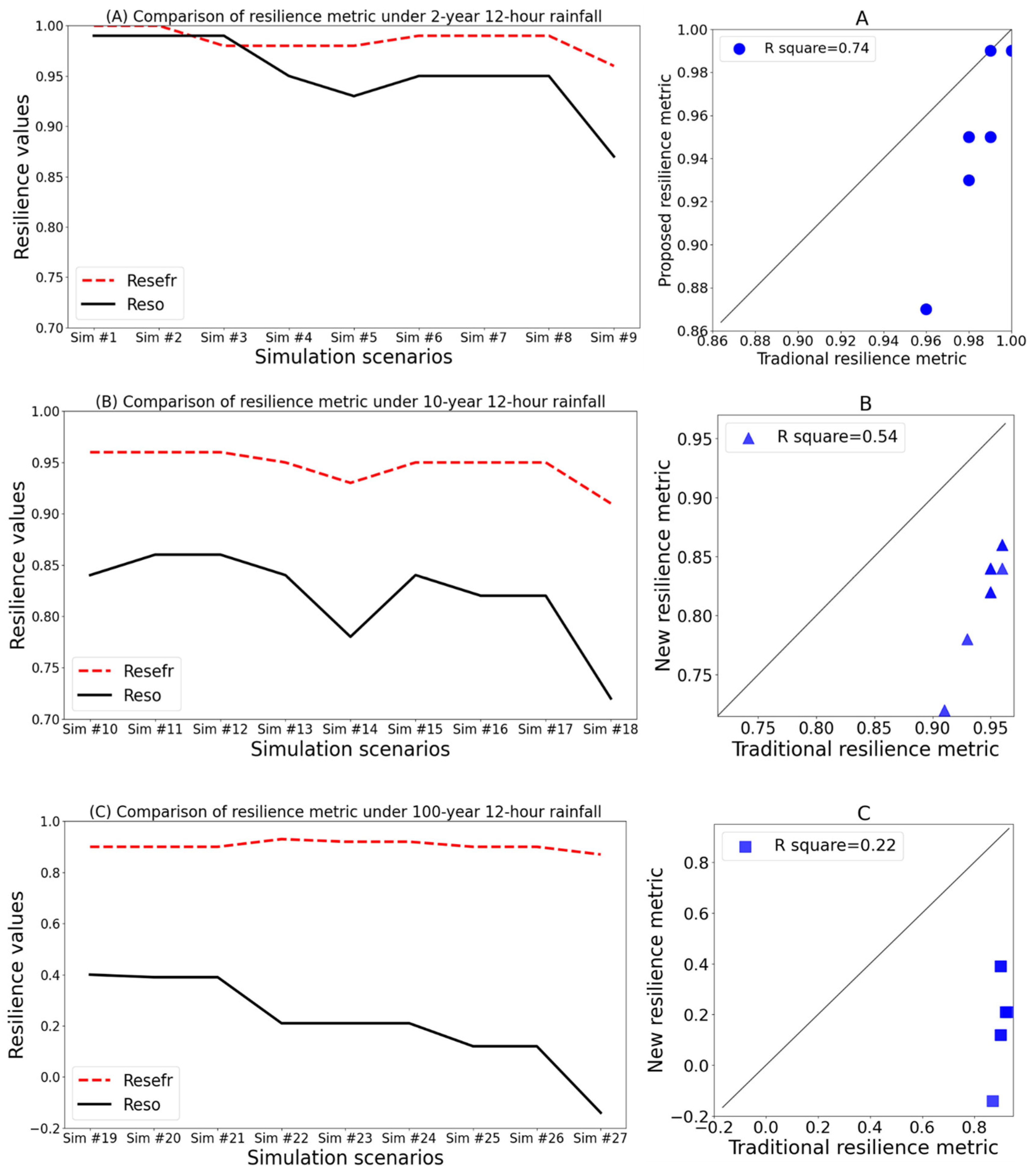
| Conduits | Sub-Catchments | Junctions | |||||||
|---|---|---|---|---|---|---|---|---|---|
| Number | Diameter (m) | Slope (%) | Roughness | Number | Area (km2) | Slope (%) | Imperviousness Ratio (%) | Number | Elevation * (m) |
| 184 | 0.5 to 1.5 | 0.06 to 0.40 | 0.01 to 0.016 | 28 | 0.04 to 0.2 | 1.6 to 6.2 | 18 to 78 | 181 | 4320 to 4370 |
| Land Cover Change | Historical | RCP4.5 | RCP8.5 | |
|---|---|---|---|---|
| Rainfall Change | ||||
| Historical_2yr_12hr | Sim #1 | Sim #2 | Sim #3 | |
| RCP4.5_2yr_12hr | Sim #4 | Sim #5 | Sim #6 | |
| RCP8.5_2yr_12hr | Sim #7 | Sim #8 | Sim #9 | |
| Historical_10yr_12hr | Sim #10 | Sim #11 | Sim #12 | |
| RCP4.5_10yr_12hr | Sim #13 | Sim #14 | Sim #15 | |
| RCP8.5_10yr_12hr | Sim #16 | Sim #17 | Sim #18 | |
| Historical_100yr_12hr | Sim #19 | Sim #20 | Sim #21 | |
| RCP4.5_100yr_12hr | Sim #22 | Sim #23 | Sim #24 | |
| RCP8.5_100yr_12hr | Sim #25 | Sim #26 | Sim #27 | |
Disclaimer/Publisher’s Note: The statements, opinions and data contained in all publications are solely those of the individual author(s) and contributor(s) and not of MDPI and/or the editor(s). MDPI and/or the editor(s) disclaim responsibility for any injury to people or property resulting from any ideas, methods, instructions or products referred to in the content. |
© 2023 by the authors. Licensee MDPI, Basel, Switzerland. This article is an open access article distributed under the terms and conditions of the Creative Commons Attribution (CC BY) license (https://creativecommons.org/licenses/by/4.0/).
Share and Cite
Li, J.; Strong, C.; Wang, J.; Burian, S. An Event-Based Resilience Index to Assess the Impacts of Land Imperviousness and Climate Changes on Flooding Risks in Urban Drainage Systems. Water 2023, 15, 2663. https://doi.org/10.3390/w15142663
Li J, Strong C, Wang J, Burian S. An Event-Based Resilience Index to Assess the Impacts of Land Imperviousness and Climate Changes on Flooding Risks in Urban Drainage Systems. Water. 2023; 15(14):2663. https://doi.org/10.3390/w15142663
Chicago/Turabian StyleLi, Jiada, Courtenay Strong, Jun Wang, and Steven Burian. 2023. "An Event-Based Resilience Index to Assess the Impacts of Land Imperviousness and Climate Changes on Flooding Risks in Urban Drainage Systems" Water 15, no. 14: 2663. https://doi.org/10.3390/w15142663
APA StyleLi, J., Strong, C., Wang, J., & Burian, S. (2023). An Event-Based Resilience Index to Assess the Impacts of Land Imperviousness and Climate Changes on Flooding Risks in Urban Drainage Systems. Water, 15(14), 2663. https://doi.org/10.3390/w15142663







